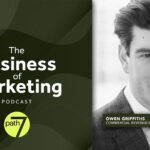By Martha Boudreau, Executive Vice President & Chief Communications and Marketing Officer, AARP
People 50+ make up nearly half of the adult U.S. population and they drive over $8.3 trillion (yes, trillion) in economic activity annually. So why is it that marketers fail to consider age as they more fully address DEI in their campaign strategies? To be clear, when I say, “more fully address,” I am referring to brand and product campaigns that continue to demonstrate a lack of understanding or an unwillingness to represent the many lifestyles and life stages of this vast segment. The lack of understanding perpetuates the use of outdated imagery, messaging and product offerings.
The history of the marketing and advertising industries often positions advertising as leading change and creating aspirational hopes and desires for consumers. But when it comes to age-based marketing, the industry is woefully out of touch with nearly half of the consuming public. That’s surprising – especially when you look at consumer data and then consider that marketing is a discipline that professes to be all about using data in order to find and target increasingly narrow audiences. Unfortunately, by turning away from the data, the industry is out of touch and is negatively impacting societal attitudes about aging by perpetuating stereotypes. This must change.
As a first step, marketers need to address their own misunderstandings and lack of knowledge about what it means to live 50+. Only then will they be open to what the data reveals. It shouldn’t surprise any marketer to learn the 50+ are spending billions to support their lifestyle. For example, they spend $742 billion on entertainment, $181 billion on clothing and footwear, and $142 billion in travel.
As America’s leading imagemakers, marketers must shift the conversation and portray aging in a more authentic way. To embrace this 50+ audience doesn’t “age up” their brands. On the contrary, it will help them connect to intersectional and universal life experiences and reach an audience that’s 70-million-plus households strong.
Accurately representing the 50+ demo is good for business and uses the power of our industry to show people that living half their lives over 50 is full of possibilities.
Here are 10 imperatives for marketers ready to embrace this growing market segment
1. Abandon the myth about consumers adopting brand loyalty in the first 20 years of life.
One long-standing myth that’s kept marketers on the sidelines is the idea that 50+ consumers established brand loyalties decades ago that can’t be broken.
In a market rich with choice and competition, nothing could be further from the truth. Fifty-plus consumers are eager to support brands that understand them; over 60% would switch to brands that they feel represent people their age and show people their age in advertising. What’s more, 19% of adults 50+ opted not to purchase from a brand after seeing advertising with ageist stereotypes. Study after study reveals the loyalty of 50+ consumers is evolving based on consumer experience and brand relevance.
2. Don’t call them “old.”
Referring to the 50+ demo as experienced or mature conveys respect and achievement. In contrast, terms like elderly and old are offensive and have no place in modern advertising.
A whopping 94% of adults 50+ say that their identity is not defined by their age. Marketers should approach age the same way they approach any diverse segment – with a recognition that this one element of diversity does not define a person let alone a consumer.
3. Improve your own understanding.
Eighty-eight percent of adults ages 50-80 say they feel more comfortable being themselves as they have gotten older. In fact, studies have repeatedly found that people say they are happiest in the 60s, 70s and 80s. Despite the research, most marketers make a fundamental mistake by casting a negative light on aging.
Why the disconnect? One likely reason is the relatively young age of advertising professionals. The average age of a creative director is 28. To reach 50+ consumers, creative teams should be as age diverse as the demo they’re targeting.
4. Avoid linking aging with extreme physical activities.
Staying healthy is important as we age, but don’t let your imagery go overboard. This might come as a surprise, but new AARP and FrameWorks Institute research found that images of 50+ adults engaged in extreme physical activities like triathlons, hang-gliding or surfing elicited a distinctly negative reaction.
Marketers should not confuse extreme sports with active lifestyles. Depictions should reflect relatable activities, like cycling, swimming, hiking or fitness training.
5. Disrupt lifestyle stereotypes with positive imagery.
Adults 50+ are no different than anyone else; They work, they play, they volunteer and connect with multiple generations of loved ones. They’re engaged with their communities. And, they’re spending $142 billion in tourism traveling the world.
Still, there’s a dearth of imagery showing adults 50+ in these settings. This creates an enormous opportunity for marketers to be at the forefront of leveraging positive imagery to present a more accurate picture of aging.
6. Don’t forget the workplace.
Marketers can combat ageism by capturing the multigenerational nature of today’s workplace, which has five generations working side-by-side.
Images of 50+ adults in workplace settings generate more positive attitudes about aging than images in household settings. Why? Because they reflect reality: 30% of the U.S. workforce is 50+. Unfortunately, few images of 50+ adults involve work settings.
7. Showcase multigenerational relationships.
Focus on what people 50+ value most – relationships. And remember, these relationships aren’t solely with peers. Many 50+ adults are heads of multigenerational households. They interact with different ages at work and in daily life, and they want to see that reflected in advertising.
Marketers who recognize the importance and diversity of 50+ relationships will strengthen their brand relevance.
8. Recognize that technology is a vital part of life 50+.
Fifty-plus technology device ownership rivals that of adults 18–49, and 70% purchased new tech in the past year. Yet just 5% of images of 50+ adults show them interacting with technology (often getting help from tech support).
Marketers who understand tech-savvy 50+ consumers are better positioned to grow their business. Marketers who don’t connect with the 50+ will miss out on the $140 billion this demo spends on technology each year and the spending is forecasted to reach $268 billion annually by 2030.
9. Reflect the strengths of the 50+.
Adults 50+ identify most with the characteristics of independence, knowledge and experience. They continue to pursue passions with curiosity and optimism, with 96% believing that “every year should be teaching us all something valuable.” Use language that reinforces these strengths and position your brand as a partner that appreciates the depth of their experiences.
10. Commit to iterate as 50+ lifestyles evolve.
Life options after 50 are evolving as rapidly as our broader society based on technology, living arrangements, education, family units and consumer spending patterns. Today’s 50+ adults are more connected, active and engaged than generations past — so it’s important advertising accurately reflects their lifestyles as they evolve.
The bottom line
Adults 50+ drive half of all consumer spending and their economic impact continues to grow. Marketers that connect with this demo with positive, realistic imagery have an opportunity to combat stereotypes – and gain a competitive edge.
Martha Boudreau Chief Communications & Marketing Officer at AARP. She will be hosting a panel, “Why Ageism Must be Part of the DE&I Discussion” with Kirsten Flanik, President and CEO of BBDO New York, on Oct. 18 at 9:30 a.m. in the Boardroom.






